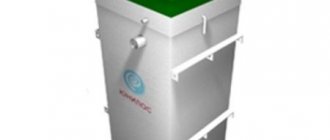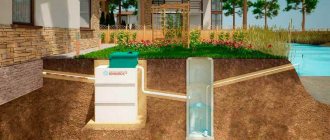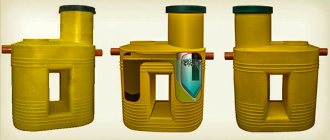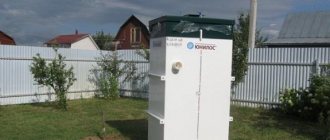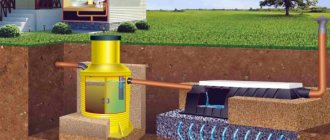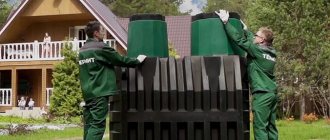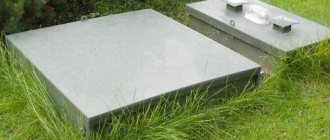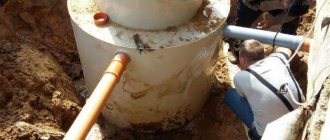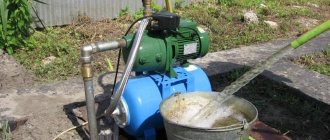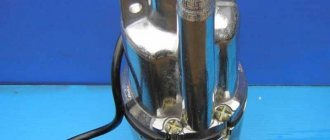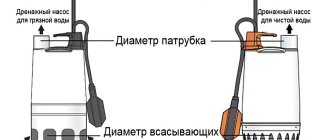Most people in the modern world want to have their own private house outside the city or at least a summer cottage. As a rule, in such holiday villages or areas where private houses are located, there is no centralized sewer system, as in cities. A little over 25 years ago, this problem was solved by digging cesspools and other similar methods. This was accompanied by unpleasant odors and overall environmental pollution. Nowadays, people strive for greater convenience. And that is why the problem of processing liquid waste has become urgent. For this purpose, special processing facilities began to be used - septic tanks. One of these devices is the Termit septic tank, designed for processing wastewater and discharging the already purified liquid into the ground.
Description and principle of operation
The Termite septic tank is manufactured in the form of a cube or parallelepiped with one or two necks. The body of this VOC is sealed, solid cast and with stiffening ribs on all sides. It is made of polyethylene. Moreover, the manufacturer uses only primary raw materials; by definition, there is no recycled plastic at the plant.
Type of septic tank Termite for a summer residence
A typical Termite septic tank consists of three chambers inside:
- To receive wastewater, sediment heavy particles and release a fatty film on top of the water.
- For settling (final clarification).
- For the processing of organic matter by anaerobic bacteria.
Septic tank Termite in section
In some designs, the second compartment is combined with the first. They differ from the standard solution by having only one neck.
In the third (last) chamber of the septic tank there is a biofilter made of synthetic fabric and microorganisms on it, as well as another filter with pumice as a filler. Termit produces output water with a purification level of around 75–85%. Then it is sent to an infiltrator, which brings the purification percentage to 98, or to a sump for pumping out using sewage trucks.
Moreover, if the option with post-treatment by drainage is chosen, then the design of the house and the layout of the site should be immediately carried out taking into account the installation of this filter on a gravel bed. Then it will be difficult to find a place for it and a septic tank. The soil moisture near the infiltrator is always higher than at a distance from it. It’s definitely not worth using the same gas blocks or timber to build buildings next to it.
Manufacturing a septic tank at the factory
How the Termite septic tank works and works
The purpose of a septic tank is to purify the wastewater entering it using sedimentation methods, decomposition of organic waste by microorganisms, and subsequent filtration.
Device
The Termite septic tank consists of the following elements:
- The body is made of durable plastic, 1.5-2 cm thick. It is divided inside into 2 or 3 chambers. Models of the Transformer series consist of 4 cameras.
- On top of the body there are 1 or 2 hatches through which the purifier is serviced.
The building contains:
- Storage tank. Wastewater flows into it.
- Bacterial treatment chamber.
- Filter element.
Termite septic tank installation
The principle of operation of the Termit septic tank
All wastewater coming from sinks, toilets, dishwashers and washing machines is sent to the first section of the septic tank. In it, the liquid settles with solid particles falling to the bottom. At the same time, a film of fat forms on the surface of the liquid. When the liquid level reaches a certain level, it flows through the pipe into the second chamber. The pipe is designed so that sediment and grease film do not flow into the next chamber.
In the second chamber, the liquid re-settles with sediment falling to the bottom. After such two settlings, the liquid already receives a certain degree of purity. Some septic tank models may not have a second chamber.
Through the overflow pipe, the liquid is directed to the next section, which contains anaerobic microorganisms. They decompose organic matter remaining in the water, resulting in the formation of sludge at the bottom of the container, and the resulting gas comes to the surface.
Water treated with microorganisms rises up and passes through a pumice filter. After filtration, it acquires a purification degree of about 70-85%. After this, the purified water enters the infiltrator (irrigation field dome), drainage well or filtration fields. As a result of such additional soil filtration, the degree of water purification reaches about 95%.
Modifications of the Termit septic tank
The model range of anaerobic septic tanks Termite is represented by two lines: “Profi” and “Transformer”. The first classic option is aimed at installation in summer cottages with seasonal residence, near bathhouses, cafes, etc. places. These stations have modifications in volume designed for 1–12 people, and are gravity-fed and energy-independent.
Based on performance and capacity, Termite Profi is divided into six modifications:
Model range of septic tanks Termit
- “1.2” for 1-2 people (400 l/day, 1200 l).
- “2.0” for 3-4 people, (800 l/day, 2000 l).
- “2.5” for 4-5 people, (1000 l/day, 2500 l).
- “3.0” for 5-6 people, (1200 l/day, 3000 l).
- “3.5” for 6-7 people, (1800 l/day, 3500 l).
- “5.5” up to 12 people, (2200 l/day, 5500 l).
Such a septic tank does not have any pumps. It doesn't need electricity to work. All flows inside and water discharge outside occur in gravity mode.
The Transformer septic tanks have two configurations: “S” and “PR”. The first is a compact autonomous sewer with one neck with a capacity of 500 to 1200 liters/day, designed for areas with low groundwater level. They, like the main model “Termite Profi”, are non-volatile.
The second are septic tanks for high groundwater, also designed for 500–1200 liters/day, but equipped with a drainage pump. Due to this, the forced release of treated waste is produced.
The Multplast assortment also includes “Termite” storage tanks, which are simply sealed containers for collecting sewage. Plus, there are autonomous “ERGOBOX” stations, which will be discussed in the next article. This is already an aerobic, energy-dependent septic tank with forced aeration inside.
Models of septic tanks Termit
| Septic tank | Human | LxWxH | Volume | Produces. | Price from* |
| Termite Pro 1.2 | 1-2 | 1340x1160x1565 mm | 1200 l | 400 l/day | 21500 rub. |
| Termite Pro 2.0 | 3-4 | 1595x1155x2005 mm | 2000 l | 800 l/day | 29900 rub. |
| Termite Pro 2.5 | 4-5 | 2000x1155x2005 mm | 2500 l | 1000 l/day | RUB 36,000 |
| Termite Pro 3.0 | 5-6 | 2300x1155x1905 mm | 3000 l | 1200 l/day | 43000 rub. |
| Termite Pro 3.5 | 6-7 | 2410x1190x2005 mm | 3500 l | 1800 l/day | 47900 rub. |
| Termite Pro 5.5 | 11-12 | 2220x1650x2395 mm | 5500 l | 2200 l/day | RUB 69,000 |
*Prices are indicative for 2021 excluding installation
Design
A modern septic tank Termite is an installation designed to receive and treat wastewater from domestic sewage systems. The model's body is made of plastic and has a rectangular shape. Inside, the structure is divided into separate sections connected by overflow devices.
Depending on the model, the installation may have two or three cameras, the purpose of each of them is:
- a storage receiver that also performs the functions of a primary settling tank;
- additional settling tank combined with a bacterial filtration chamber. To ensure the flow of biotreatment processes, plastic brushes are installed here, on the surface of which colonies of bacteria are placed that purify wastewater;
- some models also have an additional chamber for secondary water retention before being discharged outside.
Advice! This treatment plant does not require an electrical connection to operate; all processes proceed autonomously.
How does it work?
The process of sewerage wastewater treatment proceeds according to the following scheme:
- Through a pipe leading from the house, the liquid enters the storage receiver, where it remains in a state of rest for some time. During this time, heavy impurities contained in the water have time to settle to the bottom, and the water, freed from most of the inclusions, is supplied through the overflow to the next compartment;
- the overflow is located in such a way that settled particles do not have the opportunity to enter the next chamber; they remain at the bottom of the primary settling tank, where they undergo the process of anaerobic digestion;
- Once in the second section, the liquid is further settled and also subjected to biological treatment. Colonies of bacteria living in this chamber make it possible to partially remove organic contaminants;
- if there is an additional chamber, the water in it is further settled, finally freeing itself from undissolved inclusions.
Advice! The quality of cleaning when using Termit brand septic tanks ranges from 65 to 70%, so the installation of filtration fields or the installation of an irrigation dome (infiltrator) is mandatory.
Pros and cons of Termite septic tanks
The advantages of the Termite septic tank are as follows:
- A wide range allowing you to choose a model for any occasion;
- High level of purification (when using an infiltrator in the septic tank in question, it reaches 95–98%);
- Affordability in terms of the cost of the Termit VOC itself and its installation;
- Energy independence, which is very important for holiday villages remote from large cities;
- Full factory readiness of the septic tank for operation immediately after installation;
- Reliability, seamlessness and durability (up to 50 years) of the body.
Among the Termite septic tank models there are modifications both for normal conditions and for areas with high groundwater level. Plus, there is a solution for any number of people in the family. Moreover, if two dozen residents are planned to live in a house, then it is better to take a more productive autonomous station with aerobics.
The Termite septic tank has only two disadvantages:
- The need for additional treatment using an infiltrator or drainage well;
- It is mandatory to install a heavy “anchor” under the hull in case of high groundwater.
During installation, it is necessary to ensure that the Termite septic tank is filled evenly from the outside and filled with water. The stiffening ribs of the body may not withstand it if the chambers inside the VOC are empty. This is not cement-sand tiles or bricks, whose compressive strength is an order of magnitude higher. With strong external pressure, the polyethylene walls may well break through.
Video of how a Termite septic tank was crushed in the spring:
Advantages and disadvantages of using a Termit septic tank
The advantages of the device include:
- autonomy and energy independence;
- strength and resistance to pressure and temperature changes;
- ease of maintenance;
- durability;
- high degree of purity of the output water.
Of the minuses note:
- risk of wall sagging due to the rectangular design;
- possible unpleasant odor. This drawback can be eliminated by purchasing and installing special filters.
Septic tank installation
The Termit septic tank is installed quickly and easily. The description of the rules for its installation is far from a step-by-step instruction for constructing a columnar foundation with your own hands or building a house in the country. With factory VOC everything is much simpler.
To install a Termit septic tank you need:
- Dig a pit in size so that the septic tank fits completely into it, and there is 20–25 cm of voids on each side between the walls of its body and the ground.
- Dig a trench from the sewer outlet from the house to the VOC and lay a pipe there with a slope of 2 degrees towards the septic structure.
- Make another trench with a pipe to drain water into the infiltrator.
- Inspect the septic tank body for damage; it must be sealed.
- Level the bottom of the pit and compact a 3–5 cm layer of sand there.
- Place the plastic structure inside the hole.
- Fill the sides of the septic tank with a sand-cement mixture in a ratio of 5:1, while simultaneously filling it gradually with water. The level of the latter in the chambers should exceed the level of backfill by 20–30 cm.
After this, all that remains is to insulate the Termite septic tank, if required, and finally fill it up. The infiltrator is made at a distance of 2–10 meters from the VOC. And remember, the latter must be set back from all buildings on the site and even beds by at least 5 meters. Otherwise, the humidity on the ground from it is such that even façade plaster for exterior use, which is highly moisture-resistant, will begin to slide off the walls of buildings nearby.
Watch a video about installing a Termite septic tank
Principle of operation
Sewage waste goes through two levels of treatment in the septic tank: mechanical and biological. All processes occur autonomously, without the use of equipment dependent on electricity.
The wastewater flows into the receiving chamber by gravity through a sewer line laid from the house to the septic tank at a slope. In it, waste accumulates and ferments. During the settling process, large particles settle to the bottom.
The overflow into the second section is located at a sufficient height to prevent floating fractions from entering it. This chamber continues the mechanical purification of wastewater, the suspensions sink to the bottom, and the wastewater is sent to the third chamber.
The incoming water goes directly to the colonies of bacteria that colonize the innovative fibers attached to the bottom of the filter. Rising upward, the wastewater passes through a filter media packed in meshes. The water leaves the septic tank through the outlet pipe 70% purified. To achieve a higher rate, an irrigation dome is used. After the oxidation of organic residues by aerobic microorganisms, the wastewater becomes 95% safe.
Termite septic tank installation diagram
Reviews about the septic tank
Owners leave reviews for septic tanks under the Termit brand, both positive and negative. It will need to be cleaned of accumulated sludge every 2-3 years. If the groundwater is high, you will have to make an anchor for it, but this applies to almost all treatment facilities of this class. Among the shortcomings, owners who have been using Termit for several years note rather narrow necks. But this is more a matter of personal wishes.
Positive reviews
- I installed five Termite septic tanks this year. These septic tanks are analogous to Tank septic tanks. The thickness of the walls of the Termit (the manufacturer is not deceiving) is greater than that of the Tank; if the Tank 2 can be easily loaded into a car by two people, then the Termit 2F will have to be tinkered with. The stiffening ribs are also stronger than those of the Tank. Installation of Termite (taken from the technical data sheet) - the pit for installation must be 300 mm wider than the installation on each side, the container is installed on a layer of compacted sand cushion (100 mm). If the groundwater level is high, the container must be attached to a concrete slab. backfilling is carried out with a mixture of sand and cement; backfilling should be done in layers, with mandatory compaction. At the same time, fill the container with clean water so that the water level is approximately 200 mm above the backfill level. The upper surface of the septic tank is insulated (usually with polyethylene foam).
Installation must be done correctly. For example, in November last year, Tank dismantled two septic tanks due to improper installation; there were large pieces of clay in the sand-cement jacket, groundwater flowed through these inclusions, the septic tanks were compressed and they cracked. © Alexander F, forumhouse.ru
- The septic tank has been working wonderfully for six months now, nothing has been compressed, nothing has become clogged, and there is no smell. The bacteria were poured in once, but they haven’t been poured in again yet. We'll probably add it in the spring, otherwise during the winter all the bacteria there will fall asleep :) we don't regret the amount spent, because the quality is excellent! (While they were installing, through their own fault, they dropped the ladder onto the septic tank, everyone thought it would split, but no, he’s alive and well and nothing even happened to him!) In general, I recommend this product to everyone! Delivered within a week after ordering, excellent advice, reliable septic tank! © nolofinve, forumhouse.ru
- According to the strength of thermite. We had a hurricane here, fences and trees were knocked down, doghouses were scattered. Well, several inch boards 2-3 meters long flew into the end of my septic tank. Scores 3-4 millimeters deep appeared. But nothing broke through © VVSorokin, forumhouse.ru
- The first buyers who managed to purchase Termite in the first 6 months from the start of production had a positive experience and good impressions. © VodoUslugi, forumhouse.ru
Negative reviews
- Rectangle. Despite the stiffening ribs, it is subject to compression. It is advisable to sprinkle it with sand cement. And so is the septic tank and septic tank. © Vadim (spb), forumhouse.ru
- They arrived, it looks good, but the problem with the thickness of the walls is like a tank, somewhere thinner, somewhere thicker... and clearly less than stated
